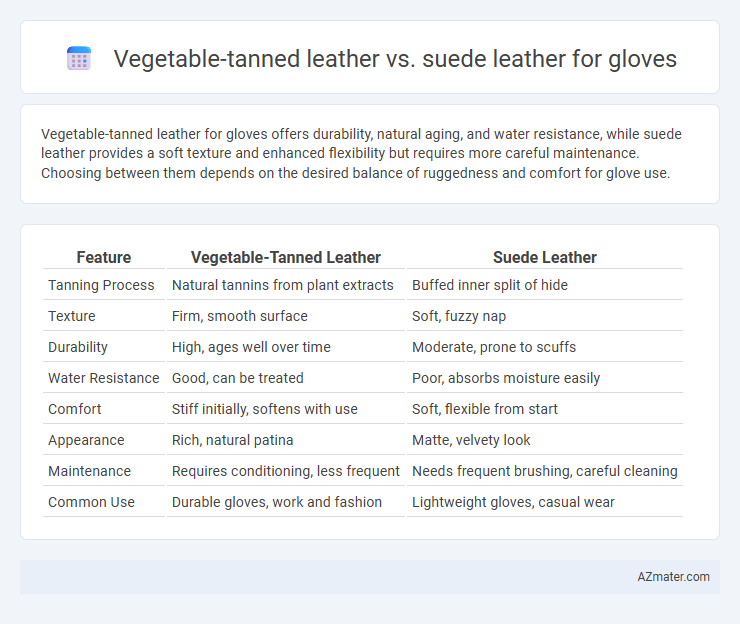Vegetable-tanned leather for gloves offers durability, natural aging, and water resistance, while suede leather provides a soft texture and enhanced flexibility but requires more careful maintenance. Choosing between them depends on the desired balance of ruggedness and comfort for glove use.
Table of Comparison
| Feature | Vegetable-Tanned Leather | Suede Leather |
|---|---|---|
| Tanning Process | Natural tannins from plant extracts | Buffed inner split of hide |
| Texture | Firm, smooth surface | Soft, fuzzy nap |
| Durability | High, ages well over time | Moderate, prone to scuffs |
| Water Resistance | Good, can be treated | Poor, absorbs moisture easily |
| Comfort | Stiff initially, softens with use | Soft, flexible from start |
| Appearance | Rich, natural patina | Matte, velvety look |
| Maintenance | Requires conditioning, less frequent | Needs frequent brushing, careful cleaning |
| Common Use | Durable gloves, work and fashion | Lightweight gloves, casual wear |
Introduction to Vegetable-Tanned Leather and Suede Leather
Vegetable-tanned leather is crafted using natural tannins from tree bark, making it durable, firm, and environmentally friendly, ideal for gloves needing long-lasting wear and a classic appearance. Suede leather, derived from the underside of the animal hide, offers a soft, velvety texture with flexibility that enhances comfort and grip in glove applications but requires more delicate maintenance. Choosing between vegetable-tanned and suede leather depends on the balance of durability, texture, and intended glove performance.
What is Vegetable-Tanned Leather?
Vegetable-tanned leather is produced using natural tannins found in plant materials such as tree bark, leaves, and fruits, resulting in a durable and eco-friendly material. This tanning process enhances the leather's firmness and develops a rich patina over time, ideal for gloves requiring both strength and a refined appearance. Unlike suede, which is made from the underside of the hide and has a napped finish, vegetable-tanned leather offers a smooth surface with distinctive grain and improved moisture resistance.
Understanding Suede Leather
Suede leather, derived from the inner split of animal hides, offers a soft, napped texture ideal for gloves requiring flexibility and comfort. Its porous surface enhances breathability but demands careful maintenance to prevent staining and wear. Unlike vegetable-tanned leather, which provides durability and a firm structure, suede's delicate finish suits gloves primarily for style and light use rather than heavy-duty protection.
Key Differences in Manufacturing Processes
Vegetable-tanned leather is crafted using natural tannins derived from tree bark, leaves, and other plant materials, resulting in a firm, durable glove that develops a rich patina over time. Suede leather is produced by sanding or buffing the inner split of the hide, creating a soft, napped finish with a more delicate texture ideal for flexibility and comfort in glove applications. The vegetable tanning process takes several weeks and enhances leather longevity, while suede manufacturing involves mechanical abrasion and typically shortens overall durability but increases softness.
Durability and Strength Comparison
Vegetable-tanned leather offers superior durability and strength for gloves due to its firm, dense fiber structure that resists wear and tear over time compared to suede leather. Suede leather, known for its softer, napped texture, provides less abrasion resistance and is more prone to damage from moisture and rough use. For glove applications requiring long-lasting performance, vegetable-tanned leather is the preferred material due to its robust durability and structural integrity.
Comfort and Flexibility for Gloves
Vegetable-tanned leather offers a firm yet supple texture that molds to the hand over time, providing durable comfort and moderate flexibility ideal for gloves requiring structured protection. Suede leather, with its soft, napped surface, delivers superior flexibility and a luxurious, breathable feel, making it perfect for gloves that prioritize comfort and dexterity. The choice between vegetable-tanned and suede leather hinges on balancing the need for long-lasting support versus enhanced softness and ease of movement in glove applications.
Breathability and Moisture Resistance
Vegetable-tanned leather offers superior breathability due to its natural tanning process that preserves the leather's porous structure, allowing air to circulate and preventing clamminess inside gloves. Suede leather, with its napped finish, typically absorbs more moisture and provides less resistance to water, making it less effective at moisture management during prolonged use. For gloves requiring both breathability and moisture resistance, vegetable-tanned leather maintains comfort and durability better than suede.
Aesthetic Appeal and Style Options
Vegetable-tanned leather offers a rich, natural patina that deepens with age, enhancing the glove's classic and sophisticated aesthetic, while suede leather provides a soft, velvety texture that adds a casual and luxurious touch to glove designs. Vegetable-tanned leather gloves typically showcase a smooth, polished finish with warm tones ranging from light tan to deep brown, appealing to traditional and rustic style preferences. Suede gloves come in a wide array of colors and maintain a matte appearance, making them ideal for contemporary and fashion-forward looks with versatile style options.
Sustainability and Environmental Impact
Vegetable-tanned leather uses natural tannins from plant sources, making it a more sustainable choice with a lower environmental impact compared to chrome-tanned leather. Suede leather, often derived from the underside of animal hides, requires chemical treatments that can release pollutants and contribute to water contamination. Choosing vegetable-tanned leather gloves supports eco-friendly practices by reducing toxic waste and promoting biodegradable materials.
Choosing the Best Leather Type for Gloves
Vegetable-tanned leather offers superior durability and natural breathability, making it ideal for gloves requiring long-lasting wear and a firm grip, while suede leather provides enhanced softness and flexibility, perfect for gloves prioritizing comfort and dexterity. Choosing the best leather type depends on the glove's intended use; vegetable-tanned leather suits heavy-duty tasks, whereas suede excels in light-duty or fashion gloves due to its plush texture. Consider factors such as exposure to elements, required protection, and tactile sensitivity to select the optimal leather for glove performance and longevity.

Infographic: Vegetable-tanned leather vs Suede leather for Glove
 azmater.com
azmater.com